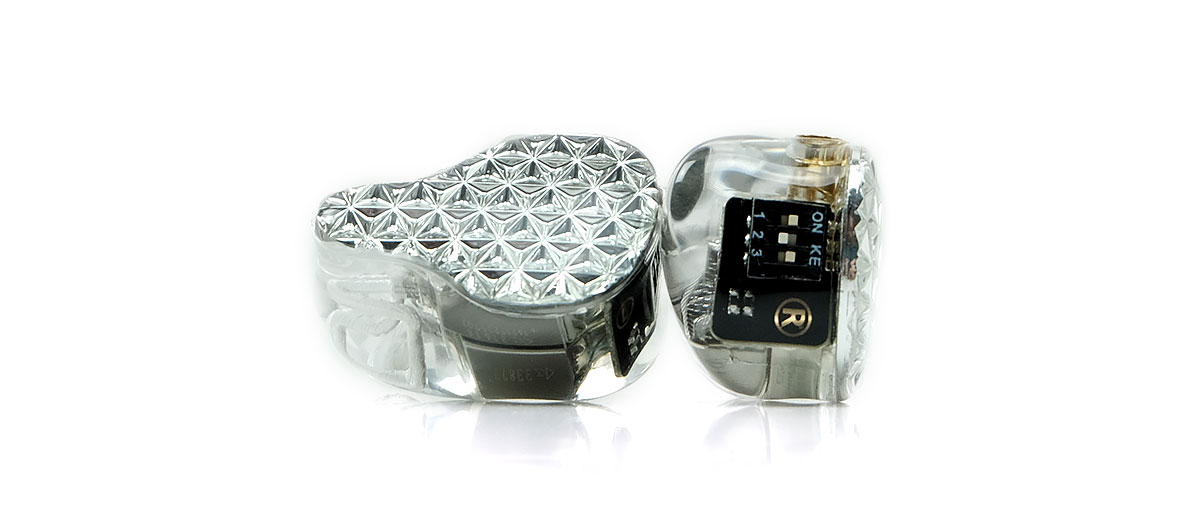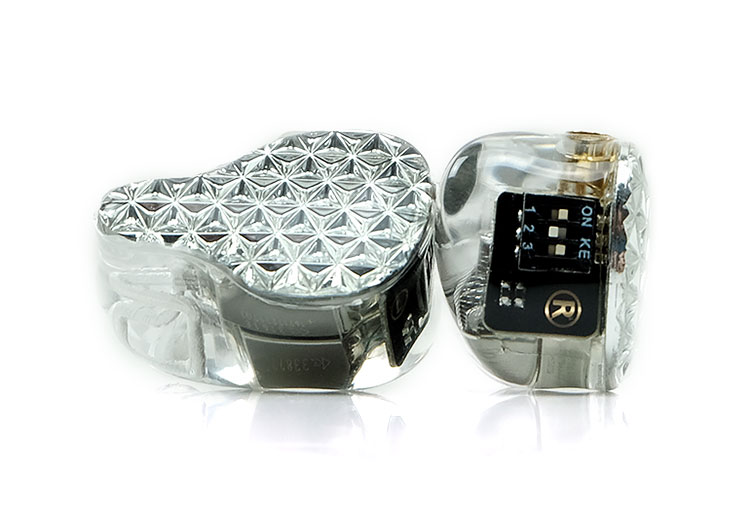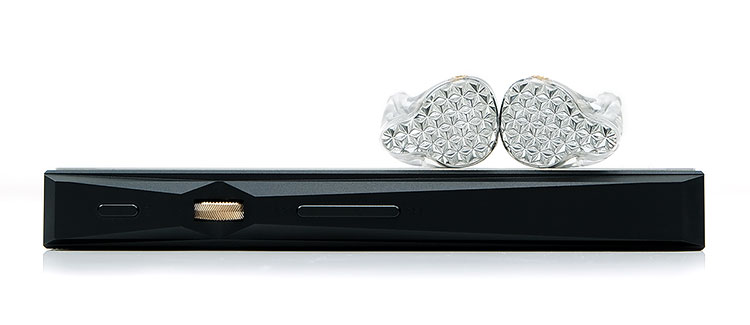Sound Impressions
Summary
The FA9 does have a core sound signature with the switches amplifying or reducing aspects of that curve selectively. This is a warm and ‘close’ tuning with plenty of bass quantity. There is a solid dip in the lower-mids, a mild bump for the vocal presence, and some clear but not overly bright treble response.
In some ways, there is a legacy aspect of the FA7 with its smooth delivery but I find the FA9 technically superior in terms of clarity and with more headroom than its 5-driver counterpart.
One of the key differences is the better level of contrast that prevents the high quantity of bass response from the FA9’s low-end driver from sounding overly bloated. It sounds big, and pretty impressive for a dual BA driver though you can tell it is a BA driver with its lack of air pressure coming at you in waves at the sub-bass level.
So, compared to the FH5 and FH7 it has a similar quantity and it does sound dense but still on the slightly polite side sub-50Hz in terms of impact. This is combined with a linear extension into the mid-bass that remains elevated until around 200Hz which carries a lot of latent warmth into the mids of the FA9.
That dip in the lower-mids can be overshadowed a little by the elevated low-end so when it gets busy you get a little less clarity and instrumental presence than I would like. However, vocals are buttery smooth and natural sounding and the level of PRaT in low-end instrumental pitching is impressive for an all-BA design.
There does seem to be a little lack of air in the upper mids which you can compensate for with tip rolling and treble boosting but you will not get the same clean presence as the FH7 or even the FH5 which have more significant vocal bumps.
Staging
The FA9 is a huge step up on the FA7 in terms of imaging. I felt the FA7 struggled a lot for air and whilst I would not say the FA9 is the airiest monitor in the world it does have significantly better staging capability in both its width and height.
Depth is relative to me for these two as both are BA but the FA9 does more with its dual BA driver in terms of quality of the layering and the level of detail its bass texture. Certainly, with the bass boost on it is the most forward aspect of the FA9 soundstage,
Mids are a mixed bunch with male vocals having a slight nudge but nowhere near as forward and focused as was the case with the FH7 and FH5. You get an impressive female vocal presence and better clarity for lower-pitching vocals when the low-end is quieter.
The resolution of the FA9 and articulation is the most impressive aspect of its staging performance. The enhanced treble clarity with treble boost on does inject some much-needed space into the mids of the FA9 and a slightly sharping of individual notes. That means imaging cues are much easier to pick out compared to the FA7.
This is not an aggressive treble. It is relatively safe though you can tease more forwardness out with the treble boost on. However, its improved airiness is easily noticeable and you do get a very light shimmer in the upper treble that was not there on the FA7.
Impedance Boost (S0)
With the impedance switch off you get a blacker background and a more neutral tuning which works wonderfully well with the bass boost off and treble on, well, at least for my preferences.
With the impedance dropped or lower (switch on) the bass has increased presence and the overall tone is more colored with enhanced bass and treble contrast. Separation and clarity drop a shade also but that can be nullified a little by keeping the bass boost off and treble boost on.
Treble Boost (S1)
I tend to keep the treble boost on at all times. It brings some welcome odd-harmonic presence in the FA9 instrumental and vocal timbre as well as enhancing perceived clarity in the mids and treble.
Timbre sounds more accurate by shaving off a little warmth off and adding some welcome contrast to the low end. Without the treble on, the timbre is too soft for me with overly rounded instrumental notes and vocals.
You can actually get the FA9 to sound relatively neutral by lowering the impedance and turning the bass boost off. Combine that with a neutral source such as FiiO’s own M15 or the M11 Pro it has a far more articulate but drier quality to its presentation and less bloom creeping into those dipped lower-mids.
Bass Boost (S2)
With the bass boost on and nothing else turned on, the FA9 has a more remote staging quality, less close but also a little safer for me in terms of a vivid exciting treble presence. Bass becomes more aggressive with a bit more bloom and aggressiveness, especially if you keep the impedance switch set for 16Ω.
You can get away with this tuning for bright EDM where the treble can often be quite bright in the mix anyway. The additional bass weight and warmth also help fatten up low-end synth notes. For rock and percussion-orientated work, I would suggest throwing on the treble boost to bring the treble forward a bit more to counter the even-harmonic bias on the low end.
I would suggest turning on the treble boost along with the bass boost to get a better balance overall between the lows and the highs on the FA9. FiiO refers to this as the standard tuning which is S0 down, S1 up, and S2 down. It does give upper mids a lift with better treble presence and air.
On a side note, logically if the treble boost is S1 up, the bass boost should have been S2 up also. Having S2 down for bass boost makes memory recall for the settings difficult to manage.
Synergy
Sensitivity
The FA9 is rated at 16-32Ω and 11dB SPL and is relatively easy to drive from most sources. This is also a variable impedance IEM with one of the switches allowing you to move between 16Ω and 32Ω to better adapt to your source’s noise floor.
The impedance selector switch on the FA9 does actually work but due to the relatively safe 111dB SPL, it will depend on the source you are pairing it with. More powerful balanced connections were particularly useful barometers.
For example, with the FA9 switched to 16Ω, which is the most sensitive level, I honestly did not hear much in the way of noise on FiiO’s own M11. Sure, the mute relay pop was a little duller with the higher impedance switch on but switching back and forth did not bring a huge change because it is already quite quiet for hiss to begin with.
In contrast, the impedance switch did make a big difference to the noise floor when paired with Hifiman’s R2R2000 which can be quite brutal in terms of noise to sensitive IEMs. With the 16Ω setting, the noise floor was fairly easy to detect. With the 32Ω setting, there was a palatable reduction in noise and more useable volume.
In all instances, the impedance selector will also reduce or increase current demand, and thus volume levels will adjust accordingly. It is not a huge jump but you will notice it going back and forth.
Pairings
I have to go with a neutral or clean source with the FA9, more M15 than M11 which can sound a shade warmer and less resolving through the mids. The M11 treble though marries well with the FA9 in a standard mode or with the treble boost on.
The M11 Pro would likely be a better candidate for pairing with the FA9 alongside the M15 if you intend to up the bass quantity as they are more resolving through the mids and treble. All 3 offer solid black backgrounds with the FA9, particularly when the impedance is dropped down to 32Ω.
The M15’s level of resolution and excellent control on the low end was probably my favorite combination with the FA9. Even with the bass boost on it still kept a superior level of separation compared to the M11.
For competitor DAPs, I felt the iBasso DX160 to be a better match for the FA9 compared to the HiBy R5. The DX160’s staging strength and reference tonality is perfect fodder for the switching personality of the FA9. It retains an excellent level of separation whilst sounding airier than the R5.
The R5 will give it some oomph but on the whole, I do not think the FA9 needs any more ‘oomph’. Separation and clarity are key for the FA9 and the DX160 does it better.
If you want a HiBy DAP then the R3 Pro’s more neutral signature does it better for me. Female vocals in particular with bass and treble boost on sound forward and nicely balanced. The FA9 is not the most demanding to power so the R3 Pro has no problems driving it also.




